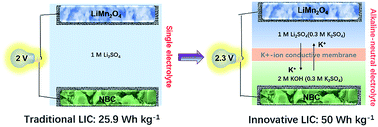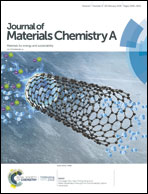A high-voltage aqueous lithium ion capacitor with high energy density from an alkaline–neutral electrolyte†
Abstract
Developing high-capacitance electrode materials with high voltage is always the essential strategy for increasing the energy densities of aqueous supercapacitors. However, it is very difficult to break through the voltage restriction of 2 V due to the narrow electrochemical window of water. Herein, we introduce a double (alkaline–neutral) electrolyte separated with a K+ conductive membrane to assemble a lithium ion capacitor (LIC) with high voltage and high energy density. This electrolyte system adequately exploits the high specific capacitance (256 F g−1) and low potential (−1–0 V vs. Hg/HgO) of nitrogen-rich biomass carbon (NBC) as an anode in alkaline mixed solution, and the large capacitance (440 F g−1) and high redox potential (0–1.2 V vs. SCE) of LiMn2O4 nanorods as a cathode in neutral mixed solution. The as-fabricated NBC//LiMn2O4 LIC realizes a stable working voltage up to 2.3 V and a high energy density of 50 W h kg−1 at 571 W kg−1 as well as excellent rate capability, and is superior to the traditional LIC and many previous carbon-based asymmetric supercapacitors in neutral electrolytes. Moreover, it presents impressive cycling life with 88% capacitance retention after 5000 cycles. These results show that this method has great promise for promoting the electrochemical performance of supercapacitors.



 Please wait while we load your content...
Please wait while we load your content...